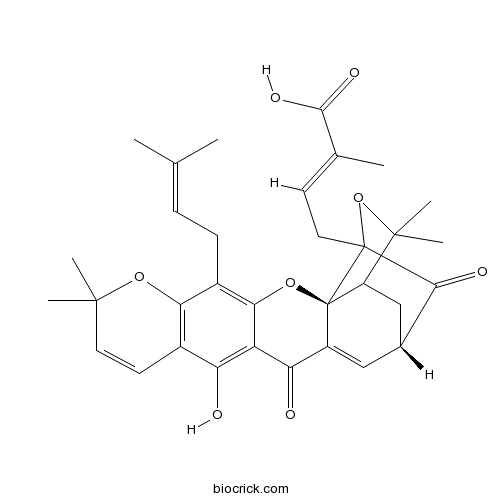Isomorellic acidCAS# 5262-69-1 |

- Morellic acid
Catalog No.:BCN3073
CAS No.:5304-71-2
Quality Control & MSDS
3D structure
Package In Stock
Number of papers citing our products

| Cas No. | 5262-69-1 | SDF | Download SDF |
| PubChem ID | 6419329 | Appearance | Powder |
| Formula | C33H36O8 | M.Wt | 560.7 |
| Type of Compound | Miscellaneous | Storage | Desiccate at -20°C |
| Solubility | Soluble in Chloroform,Dichloromethane,Ethyl Acetate,DMSO,Acetone,etc. | ||
| SMILES | CC(=CCC1=C2C(=C(C3=C1OC(C=C3)(C)C)O)C(=O)C4=CC5CC6C4(O2)C(C5=O)(OC6(C)C)CC=C(C)C(=O)O)C | ||
| Standard InChIKey | COVMVPHACFXMAX-PZMZKOKMSA-N | ||
| Standard InChI | InChI=1S/C33H36O8/c1-16(2)8-9-20-26-19(11-12-30(4,5)39-26)24(34)23-25(35)21-14-18-15-22-31(6,7)41-32(28(18)36,13-10-17(3)29(37)38)33(21,22)40-27(20)23/h8,10-12,14,18,22,34H,9,13,15H2,1-7H3,(H,37,38)/b17-10+/t18-,22?,32?,33-/m1/s1 | ||
| General tips | For obtaining a higher solubility , please warm the tube at 37 ℃ and shake it in the ultrasonic bath for a while.Stock solution can be stored below -20℃ for several months. We recommend that you prepare and use the solution on the same day. However, if the test schedule requires, the stock solutions can be prepared in advance, and the stock solution must be sealed and stored below -20℃. In general, the stock solution can be kept for several months. Before use, we recommend that you leave the vial at room temperature for at least an hour before opening it. |
||
| About Packaging | 1. The packaging of the product may be reversed during transportation, cause the high purity compounds to adhere to the neck or cap of the vial.Take the vail out of its packaging and shake gently until the compounds fall to the bottom of the vial. 2. For liquid products, please centrifuge at 500xg to gather the liquid to the bottom of the vial. 3. Try to avoid loss or contamination during the experiment. |
||
| Shipping Condition | Packaging according to customer requirements(5mg, 10mg, 20mg and more). Ship via FedEx, DHL, UPS, EMS or other couriers with RT, or blue ice upon request. | ||
| Description | 1. Isomorellic acid is a cytotoxic caged xanthone. |

Isomorellic acid Dilution Calculator

Isomorellic acid Molarity Calculator
| 1 mg | 5 mg | 10 mg | 20 mg | 25 mg | |
| 1 mM | 1.7835 mL | 8.9174 mL | 17.8348 mL | 35.6697 mL | 44.5871 mL |
| 5 mM | 0.3567 mL | 1.7835 mL | 3.567 mL | 7.1339 mL | 8.9174 mL |
| 10 mM | 0.1783 mL | 0.8917 mL | 1.7835 mL | 3.567 mL | 4.4587 mL |
| 50 mM | 0.0357 mL | 0.1783 mL | 0.3567 mL | 0.7134 mL | 0.8917 mL |
| 100 mM | 0.0178 mL | 0.0892 mL | 0.1783 mL | 0.3567 mL | 0.4459 mL |
| * Note: If you are in the process of experiment, it's necessary to make the dilution ratios of the samples. The dilution data above is only for reference. Normally, it's can get a better solubility within lower of Concentrations. | |||||

Calcutta University

University of Minnesota

University of Maryland School of Medicine

University of Illinois at Chicago

The Ohio State University

University of Zurich

Harvard University

Colorado State University

Auburn University

Yale University

Worcester Polytechnic Institute

Washington State University

Stanford University

University of Leipzig

Universidade da Beira Interior

The Institute of Cancer Research

Heidelberg University

University of Amsterdam

University of Auckland

TsingHua University

The University of Michigan

Miami University

DRURY University

Jilin University

Fudan University

Wuhan University

Sun Yat-sen University

Universite de Paris

Deemed University

Auckland University

The University of Tokyo

Korea University
- Ponicidin
Catalog No.:BCN3231
CAS No.:52617-37-5
- Deacetylasperulosidic acid methyl ester
Catalog No.:BCN1427
CAS No.:52613-28-2
- Epipterosin L
Catalog No.:BCN5680
CAS No.:52611-75-3
- H-Sar-OEt.HCl
Catalog No.:BCC3334
CAS No.:52605-49-9
- Conduritol A
Catalog No.:BCN5683
CAS No.:526-87-4
- D(-)-Tartaric acid
Catalog No.:BCN8460
CAS No.:526-83-0
- Trachelanthamidine
Catalog No.:BCN1991
CAS No.:526-64-7
- Isoretronecanol
Catalog No.:BCN1993
CAS No.:526-63-6
- Tryptophol
Catalog No.:BCN5681
CAS No.:526-55-6
- Abrine
Catalog No.:BCN2348
CAS No.:526-31-8
- Sesamolin
Catalog No.:BCN1289
CAS No.:526-07-8
- Eudesmin
Catalog No.:BCN6563
CAS No.:526-06-7
- Gnetofuran B
Catalog No.:BCN7764
CAS No.:526214-79-9
- Huwentoxin IV
Catalog No.:BCC6270
CAS No.:526224-73-7
- Dehydroadynerigenin digitaloside
Catalog No.:BCN4623
CAS No.:52628-62-3
- Siegeskaurolic acid
Catalog No.:BCN6982
CAS No.:52645-97-3
- Anisodine
Catalog No.:BCN1868
CAS No.:52646-92-1
- Kirenol
Catalog No.:BCN5682
CAS No.:52659-56-0
- A23187, free acid
Catalog No.:BCC6980
CAS No.:52665-69-7
- D-Penylalaninol
Catalog No.:BCC2715
CAS No.:5267-64-1
- Sodium Gluconate
Catalog No.:BCC4721
CAS No.:527-07-1
- Azomycin
Catalog No.:BCC5315
CAS No.:527-73-1
- Herbacetin
Catalog No.:BCN1268
CAS No.:527-95-7
- Ginsenoside Rd
Catalog No.:BCN1074
CAS No.:52705-93-8
Improved high-performance liquid chromatographic method for simultaneous determination of 12 cytotoxic caged xanthones in gamboges, a potential anticancer resin from Garcinia hanburyi.[Pubmed:18254140]
Biomed Chromatogr. 2008 Jun;22(6):637-44.
The potential anti-tumor activity of gamboges, a herbal medicine derived from Garcinia hanburyi, has increasingly gained the interest of scientist worldwide. The major components of gamboges are cytotoxic caged xanthones. In the present study, an improved HPLC method was developed to simultaneously quantify 12 caged xanthones, including three pairs of epimers and four pairs of trans-cis isomers, i.e. forbesione, Isomorellic acid, morellic acid, R-30-hydroxygambogic acid, S-30-hydroxygambogic acid, isogambogenic acid, gambogenic acid, gambogellic acid, R-isogambogic acid, S-isogambogic acid, R-gambogic acid and S-gambogic acid. This method was validated to be sensitive, precise and accurate with limits of detection of 0.03-0.08 microg/mL, overall intra-day and inter-day variations less than 7.9% and overall recovery over 93.2%. The correlation coefficients (r(2)) of the calibration curves were higher than 0.995 for all analytes. The newly established method was successfully applied to reveal the difference in the chemical profiles and contents of these analytes in gamboges from different origins. It can be concluded that this method was not only an effective quality control method to ensure the safety and efficacy consistency of gamboges, but also a useful tool for screening and determining more potent cytotoxic xanthones with potential anticancer activity.


